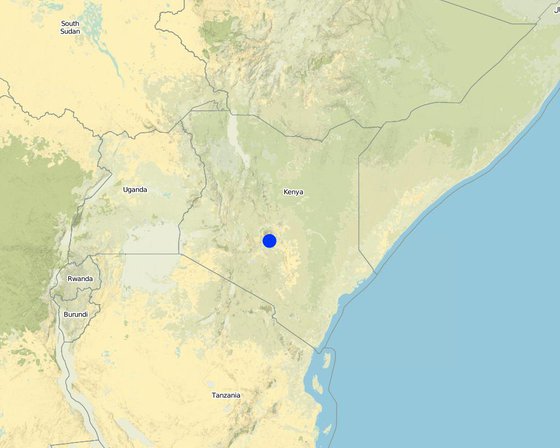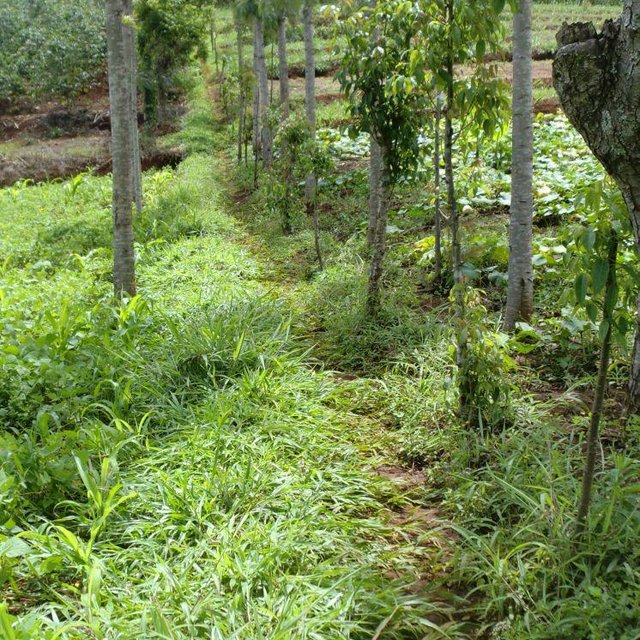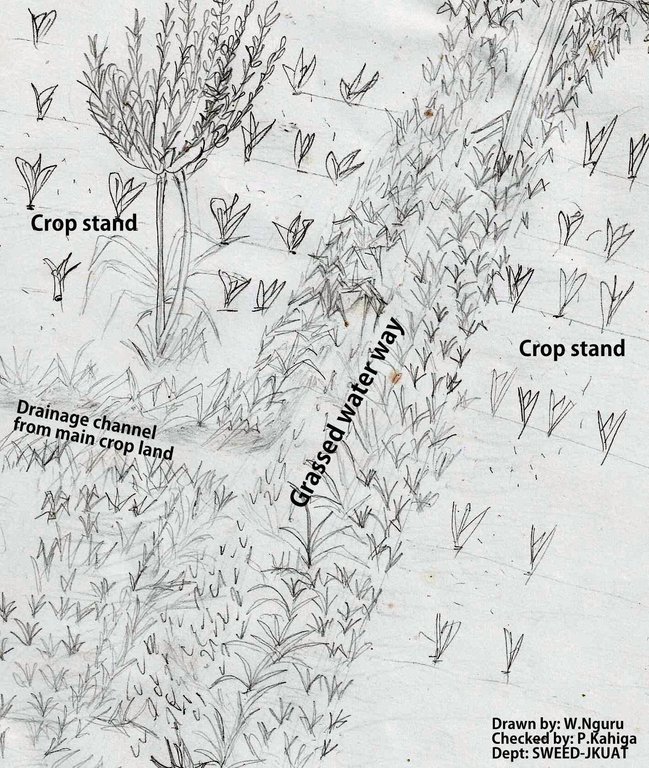



Grassed waterways are natural or constructed channels established for transport of concentrated flow at safe velocities using adequate vegetation. They are generally broad and shallow by design to move surface water across farms without causing soil erosion. The vegetative cover slows the water flow, minimizing channel surface erosion. When properly constructed, grassed waterways can safely transport large water flows down slope. These waterways can also be used as outlets for water released from contoured and terraced systems and from diverted channels. This practice reduces sedimentation of nearby water bodies and pollutants in runoff.
Purpose of the Technology: In Embu District, waterways are constructed to act both as a channel of disposing run-off into the river and a foot path. The type of vegetation that is used in this district is fodder grass called paspalum. They are used on slopes of less than 20% and where flow velocities do not exceed 1.8 m/s. They are also suitable in areas where rainfall intensities are high and excess run-off is frequent, such as slopes in humid regions, in semi-arid or arid regions where soil infiltration rates are low and run-off is concentrated, where cultivated fields have been treated with various types of terracing systems and drainage is necessary and on non-cultivated lands to connect run-off drainage structures such as diversions, cut-off ditches. Advantages of grassed waterways include flood damage prevention; erosion control; aesthetic value; water quality improvement; design based on landowner’s/farmer’s experience; soluble contaminant flow retardation; and dispersion of concentrated flow, thereby minimizing gully erosion.
Establishment / maintenance activities and inputs: Limitations of this practice include the cost of installation (e.g., grading slopes and vegetation establishment), loss of acreage for pasture or crops and the variability of effectiveness due to the uncertainty of runoff rate and frequency. Disadvantages of a grassed waterway include working around it with farm equipment, vegetative growth may be troublesome and the depth of the waterway limits it as a tile drainage outlet. The construction of the waterway will depend on the soil’s erosive potential. For example, a shallower waterway will result in an area with more erodible soil. Depending on the equipment and labor costs, grading, seed and fertilizer selected, the cost of establishing grassed waterways will vary. However in most cases where no additional structures are constructed on the waterway, grassed waterways are cheap to construct. Potential returns include fodder for feeding the farmers animals which is very common in Embu North District.

ទីតាំង: Embu North District, Eastern Province, ប្រទេសកេនយ៉ា
ចំនួនទីកន្លែងបច្ចេកទេស ដែលវិភាគ:
ការសាយភាយនៃបច្ចេកទេស: ត្រូវបានផ្សព្វផ្សាយត្រឹមតំបន់មួយ (approx. 1-10 គម2)
តើស្ថិតក្នុងតំបន់ការពារអចិន្ត្រៃយ៍?:
កាលបរិច្ឆេទនៃការអនុវត្ត:
ប្រភេទនៃការណែនាំឱ្យអនុវត្តន៍៖




| បញ្ជាក់ពីធាតុចូល | ឯកតា | បរិមាណ | ថ្លៃដើមក្នុងមួយឯកតា (Kshs) | ថ្លៃធាតុចូលសរុប (Kshs) | % នៃថ្លៃដើមដែលចំណាយដោយអ្នកប្រើប្រាស់ដី |
| កម្លាំងពលកម្ម | |||||
| Planting grass | ha | 1,0 | 10,0 | 10,0 | 100,0 |
| សម្ភារៈ | |||||
| Tools | ha | 1,0 | 20,0 | 20,0 | 100,0 |
| សម្ភារៈដាំដុះ | |||||
| Grass seeds | ha | 1,0 | 25,0 | 25,0 | 100,0 |
| ថ្លៃដើមសរុបក្នុងការបង្កើតបច្ចេកទេស | 55.0 | ||||
| ថ្លៃដើមសរុបក្នុងការបង្កើតបច្ចេកទេសគិតជាដុល្លារ | 0.55 | ||||
| បញ្ជាក់ពីធាតុចូល | ឯកតា | បរិមាណ | ថ្លៃដើមក្នុងមួយឯកតា (Kshs) | ថ្លៃធាតុចូលសរុប (Kshs) | % នៃថ្លៃដើមដែលចំណាយដោយអ្នកប្រើប្រាស់ដី |
| កម្លាំងពលកម្ម | |||||
| Reseeding | 10m | 1,0 | 2,5 | 2,5 | 100,0 |
| Replanting of grass vines | 500, | 1,0 | 2,5 | 2,5 | 100,0 |
| ថ្លៃដើមសរុបសម្រាប់ការថែទាំដំណាំតាមបច្ចេកទេស | 5.0 | ||||
| ថ្លៃដើមសរុបសម្រាប់ការថែទាំដំណាំតាមបច្ចេកទេសគិតជាដុល្លារ | 0.05 | ||||
Fodder grass, pathways and acts as boundaries
Depends on the type of grass